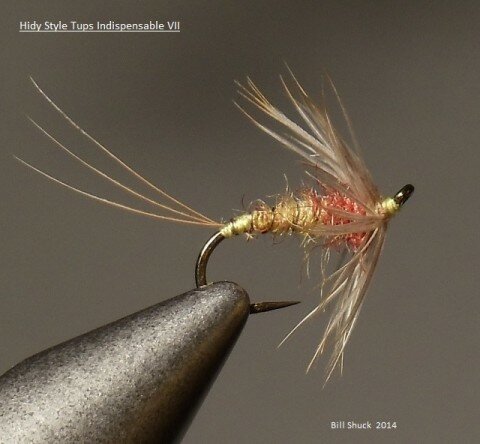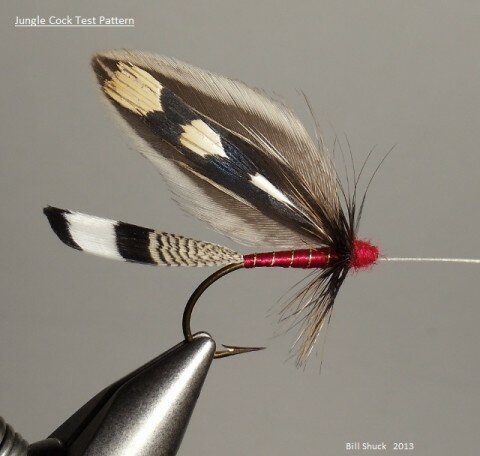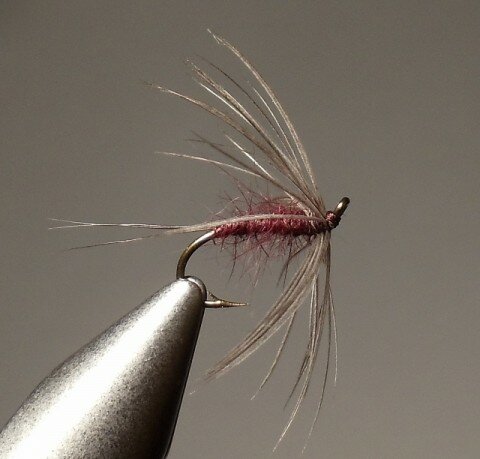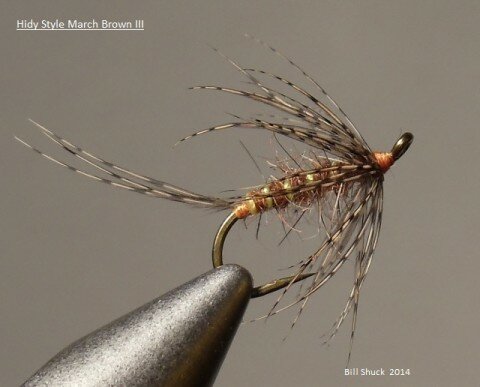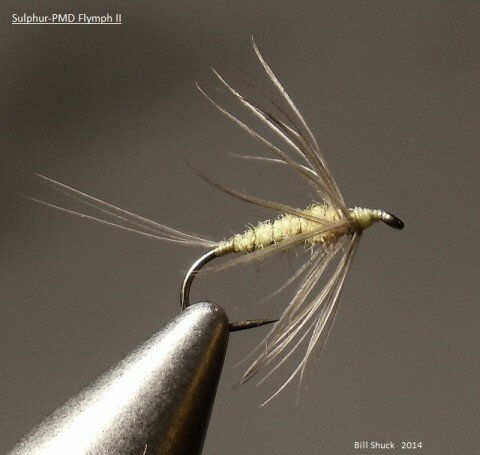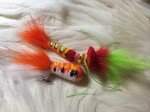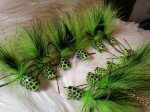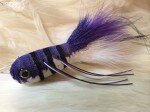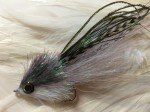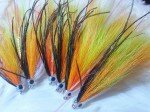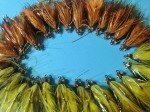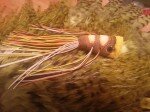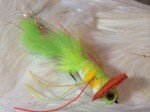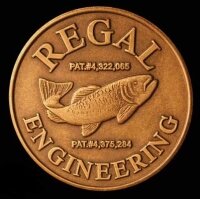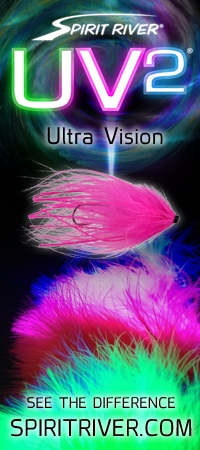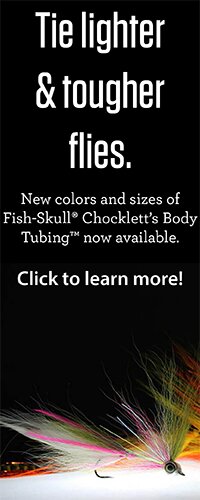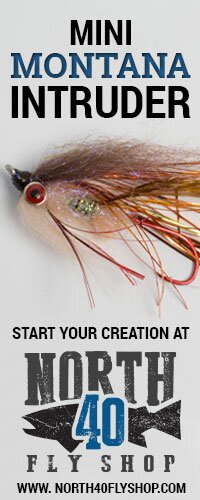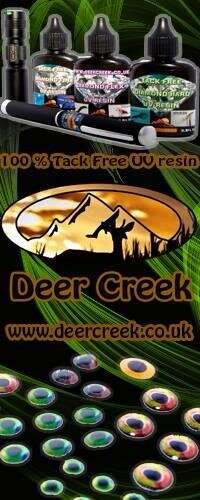Monthly Archives: May 2014
Darbee Two Feather fly – Ted Patlen
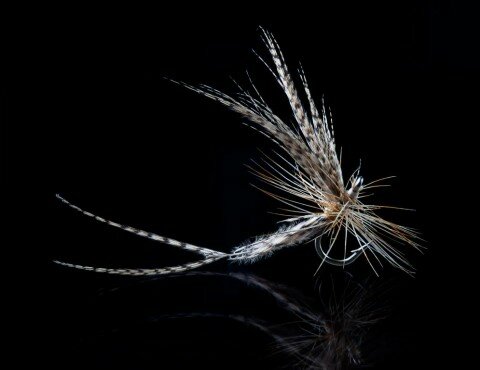
photo by TC Geist
This Darbee Two Feather fly was originated by the great Harry Darbee and this one was tied by the very talented Catskill tyer, Ted Patlen. The pattern consists of a standard dry fly hook, Wood Duck Flank Feather (or Mallard), and dry fly hackle of your choice. Here are some tips from Ted.
This fly is a model of efficiency ….easy to tie, floats like a cork, even if the hackle gets screwed up.
The bottom hackles can be cut if the fly gets some refusals.
One thing I like about it….when fishing it on a flat pool with nothing rising this fly (like a variant) will get fish to react. It is easy to twitch and skitter , another thing, how many of these flies do you think the trout see, even in Roscoe, NY? Obviously, it doesn’t work ALL the time but more than a few times to warrant this as a good fishing fly.
Another thing, an extremely large mayfly can be tied onto a very small hook.
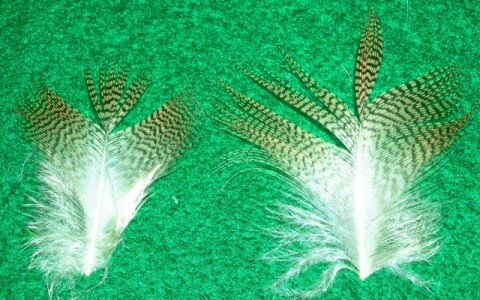
The people who wanna tie it for the first time…much care should be taken to find a good feather for the body/tail/wing feather. The feather on the left has fibers that are pretty even in legnth, not a hard taper from the tip to the base AND the fibers are very even …balanced is a better word as compared to the feather on the right ….the feather on the right would make an unbalanced wing. Look at the flues sticking out from the left side of the shaft. These are longer than the flues on its other-side . These unbalanced feathers can be used for the this fly but the even feathers are much easier to use.
Filed under Catskill, Classic, Trout flies
The River DVD and Blue-ray – Available Now!
Robert Thompson and Third Year Fly Fisher have released The River. I’ve been waiting for this one and I’m a little behind on getting it up here on FrankenFly, because I thought I had already posted it. Anyway, my copy is on its way, so I haven’t seen it yet myself, but I’m hearing nothing but great things about it. So I will be excited to kick back and enjoy this one. The DVD and Blue-ray contain The River, The Brothers Brown, and Summers. The DVD running time is 3 hours. I’ve included the trailer for each below.
You can purchase the The River DVD or Blue-ray at the Third Year Fly Fisher website or at these fine fly shops.
Gates Lodge (Grayling, MI)
Schultz Outfitters (Ypsilanti, MI)
Old AuSable (Grayling, MI)
Fullers NBOC (Lovells, MI)
Three Forks Outfitters (Midland, MI)
AuSable Anglers (Mio, MI)
Nomad Anglers (Lansing/Grand Rapids, MI)
RW Summers Rods (Traverse City, MI)
Lunds Fly Shop (River Falls, WI)
Chicago Fly Fishing Outfitters
Flymart (Canada)
Filed under New Product
Dorato Hare’s Ear
Tightline Productions brings us the Dorato Hare’s Ear. I wanted to add to this post a comment by a personal friend of Bill Dorato, the creator of this fly. Ed over at the SparseGreyMatter.com forum had this information and posted it in a thread and I thought it was interesting.
I viewed the video and found it overall well done..a few comments : when i first started fishing with Bill,in 1967 he had just developed the hare’s ear to match the bouncing caddis on the Battenkill..a twitch just before the fly got to the slashing riser usually resulted in a take…by the way, Willie never ever cut the belly hackle on his fly…that was Dick’s idea which he inserted into his article in Fly Fisherman magazine..In fact, Willie and I talked about this at length..he believed for a fly to be twitched, the hackle should not be cut as the bristle finish would cause the fly to break thru the surface film impeding a skitter…One evening we were fishing the Battenkill in Vermont when a #18 mayfly started hatching..I threw my hare’s ear over the fish and he took…Willie asked me what fly and I said “your hare’s ear” and we both laughed..Since then we decided if a hare’s ear was to be used for a mayfly, we would split the wings and lenghten the tails…for a caddis, the tails were to be tied 1/4 shank length and the wood duck wing need not be divided…i still have a few of Willie’s ties and love to look at them when i’m feeling down..What memories…In 1967, Dick and I drove to Montana where we encountered maybe 5 fishermen in our 3 week stay…in the Barns pool on the Upper Madison, I murdered the big browns using my favorite fly..a #16 Dorato Hare’s Ear! Thanks for the trip down memory lane…
Hidy and MOM
Bill Shuck sent me a couple more patterns, so I thought it would make a good follow-up post to yesterday’s. I’ll let Bill take it from here.
The first is another Hidy-style flymph, this one a soft-hackle take on an old English dry fly pattern known as the “Tups Indispensable”. There are references in the literature to a truly offbeat combination of materials used for the original dubbing, but according to the recipe published by Overfield, those used by Pete Hidy were quite mundane: pink and yellow wool mixed with a small pinch of hare’s cheek fur. These components were arranged in the spun body (with Pearsall’s Gossamer #3 primrose silk thread) so that the amount of pink increased along with the taper, culminating in a nearly red thorax. This configuration is supported by examination of actual flies tied by Pete Hidy contained in the collection inherited by his son Lance.
(per T. Donald Overfield’s “Famous Flies and their Originators”)
Hook: Long shank mayfly, Sizes #13, #14, or #15 (Pete Hidy’s favorite was an up-eye version made by Veniard; I think this one is a Size #14 Mustad 94842)
Thread: Pearsalls’ Gossamer silk #3, primrose
Hackle: Medium honey dun hen
Tail: Honey dun hen whisks
Rib: Fine gold wire
Body: Blend of pink and yellow wool with pinch of hare’s cheek fur, spun in primrose silk on a Clark block
The second fly was a byproduct of a project I worked on a while back with Don Bastian on the fanciful wet flies of Mary Orvis Marbury. This made-up pattern combines two types of feathers from a Jungle Cock fowl serving as a wing on top of a silk floss body, a barred wood duck tail, a Greenwell-type hackle collar and a red Berlin wool head covering the snelled connection to a real silk gut leader. This type of connection was pretty much standard operating procedure in the days before eyed hooks were widely available. Although they may look unrealistic to today’s anglers, such gaudy wet flies were widely used by American anglers in the 19th Century for pursuing both trout and bass.
Hook: Mustad 3399, Size #4 with eye cut off
Thread: Uni-Thread 6/0, white
Snelled leader: #4 Silk Fishing Gut (4 lb test), approximately 6” long with Perfection loop on end
Tail: Barred wood duck flank slips
Rib: Braided silver tinsel, medium
Body: Alec Jackson premium silk floss, red
Wing: Jungle Cock flank feathers with J.C. nails overlaid
Hackle collar: Greenwell (light furnace) hen hackle
Head: Red Berlin wool
Filed under Trout flies
Bill Shuck
I’ve been following Bill Shuck’s fly tying ever since I saw an Isonychia Flymph he tied in Hidy style. Hans Weilenmann actually followed that up with a fly tying video showing how to tie the Isonychia Flymph that Bill had tied. Below, Bill gives us a brief introduction to his tying, which is followed by two more Hidy style flymphs. There will be more to come from Bill here on FrankenFly in the future.
I’ve been tying seriously for about 15 years, starting out with dry flies and streamers strictly for my own use on the Gunpowder River in Maryland where I live. A fishing buddy convinced me to investigate the world of nymphs, but eventually I discovered the simple beauty of classic soft hackle flies and have been more or less fixated on them ever since. Much of my interest along these lines has been sparked through active participation in a website called “Flymphforum”, a group of like-minded folks from around the world who willingly share their considerable skill and knowledge of both traditional North Country soft hackled patterns and more recent styles such as those introduced into the U.S. by Jim Leisenring and Pete Hidy.
Here are photos and recipes for a couple of flies I’ve tied in the last few months, during which time I undertook to learn how to replicate the patterns tied by V.S. “Pete” Hidy, a friend of James E. “Big Jim” Leisenring of Pennsylvania. These two gentlemen developed a fly type that was designed to imitate the transitional stage in the life of an aquatic insect where it is no longer really a nymph, but not yet a fully developed adult fly either; hence the hybrid name “flymph”. As you might suspect, these patterns have characteristics of both nymphs and adults, using blends of natural furs spun on colored silk threads and mobile feather hackles to give an impression of real life insects in a semi-helpless condition. As evolved by Hidy after Leisenring had died, Pete’s flymphs exhibit common physical characteristics, including wispy tail whisks, tapered bodies, flowing, full soft hackle, and conical heads. I would like to acknowledge that my efforts to master this style were aided immeasurably by input from Lance Hidy, Pete’s son and valued member of the aforementioned internet group.
The first is a pattern called “March Brown” as tied by Pete Hidy according to Donald T. Overfield’s book “Famous Flies and their Originators” (Adam & Charles Black, London, 1972)
Hook: Long shank mayfly, Size #10 or #12
Thread: Pearsall’s Gossamer silk #19, hot orange
Hackle: Brown Hungarian partridge
Tail whisks: Brown partridge
Rib: Gudebrod “D” rod winding thread as sub for primrose silk or gold wire
Body: Blend of hare’s poll fur and orange-brown wool spun in hot orange silk on a Clark block
The second is a pattern of my design called “Sulphur-PMD Flymph” tied in the style of Pete Hidy.
Hook: Standard dry fly, Size #14 or #16
Thread: Pearsall’s Gossamer silk #3, primrose
Hackle: Medium blue dun hen
Tail: Blue dun hen whisks
Rob: Fine gold wire
Body: Blend of creamy fox fur and light yellow wool spun on a Clark block with a touch of orange in the thorax area
Filed under Trout flies
Holy Grail Nymph – Tim Cammisa
I thought Tim’s presentation of the Holy Grail Nymph from Orvis was really interesting this week. See what you think.
Filed under nymphs, Trout flies
CDC Emerger
This very calming fly tying video by SMHAEN Fly Fishing shows how to tie a CDC Emerger. I especially like the way he ties the wing on this one. The fly is beautifully tied.
Filed under Trout flies
Hendrickson Sparkle Dun
For those of you having visions of Hennies dancing in your head this time of year, this one’s for you!
Filed under Trout flies
Water Edge Fly Company
Jason and Toni Haddix are the owners of Water Edge Fly Company. They do commercial fly tying, destination fly tying and retail web sales of flies, materials and accessories. They tie stacked hair bass bugs, pike flies, musky flies, carp flies, streamers, and saltwater flies. They also tie for just about anything by request including destination trips around the world and custom orders for almost any species. Each pattern is proudly tied in the United States, in Colorado.
Jason has been production tying for over 15 years and supplying guides, outfitters, shops, and the public with high quality bugs behind the scenes. Jason says, “Our goal is to put high quality flies in peoples hands at the best possible price point and do it all here in the U.S.”
- 7x Popper – Low & Slow Slider – Banded Diver
- Ultimate Popper
- Tube Slider
- Midnight Madness
- Articulated Deceiver
- Bottom Dweller
- Rubber Tail Bass Bug
- Weild Card
Filed under Largemouth, Smallmouth

